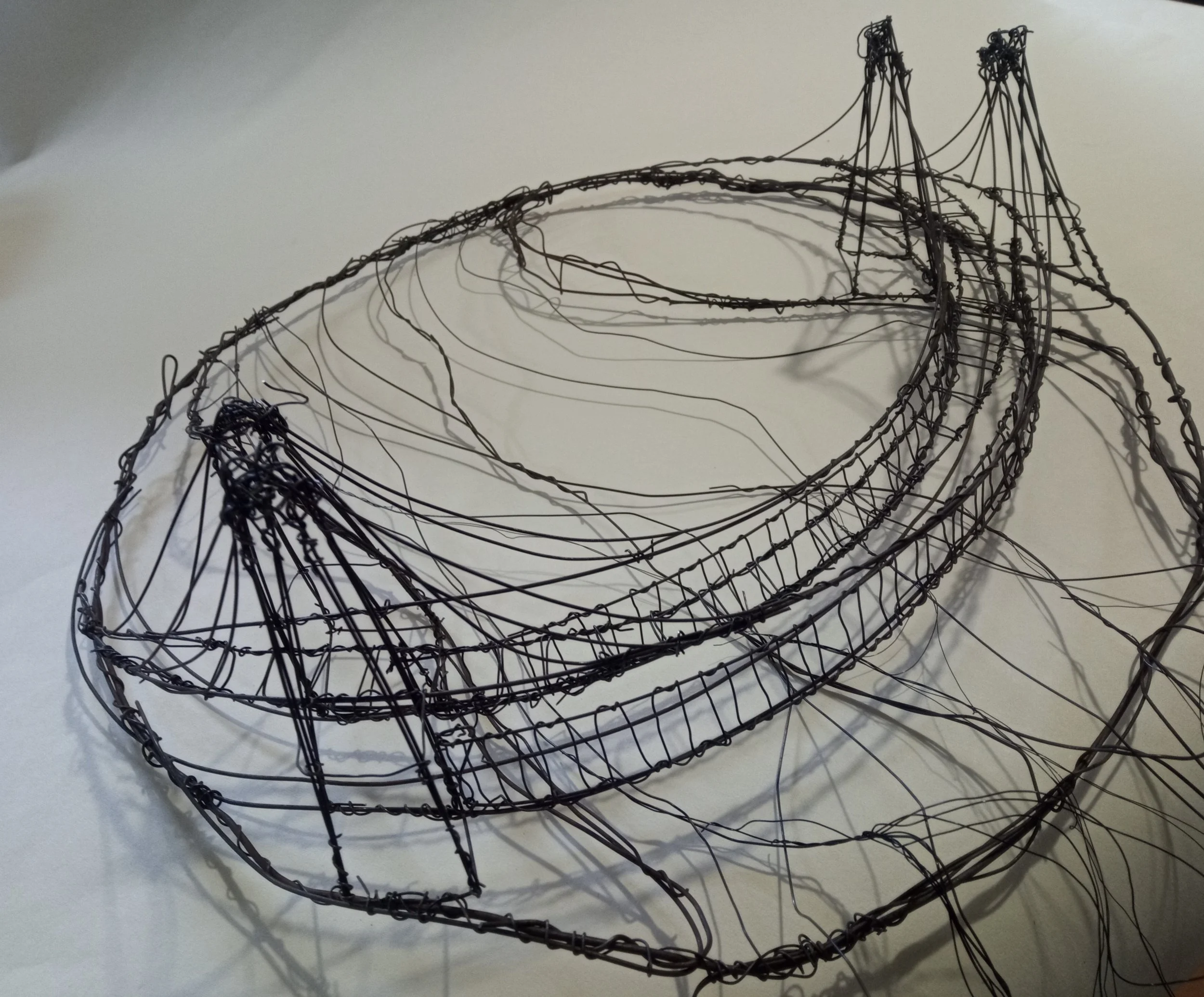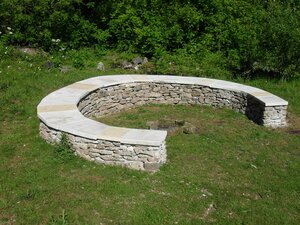SCULPTURAL CERAMICS
I enjoy working with clay and with my own practice am often inspired by lines and movement found in nature and the local landscape to create forms that invite the viewer to move around it, experiencing constantly changing shapes and which reflects my approach to designing for dance.
I use hand-built slabs that are then cut into shapes, burnished and glazed with monochrome colours to highlight their form.
Wire sculpting
AMBERGATE WIREWORKS - THE PART THEY PLAYED
Solo exhibition - Wirksworth Arts Festival 2023
Derby Museum of Making 2022. Funded by Arts Council England
My sculptural wire drawings in the immersive sculptural installation, Ambergate Wireworks - The Part They Played, look at the impact of Richard and Johnsons wire on specific landscapes and moments in time, along with the legacy left on our lives, in communication, energy, warfare and freedom of movement. Some are a response to stories told to me by those who worked there.
I immersed myself in the linear nature of wire as I drew, exploring its malleability and ability to increase its strength, by winding together multiple lengths of curved wire. Each piece developed into 3D circular landscapes, designed to be viewed from all angles, as they tell their own story. By shining a light around the suspended wire landscape, the shadows take you on a virtual journey in space. I named each piece using song titles that reflected their state of being.
When lit with a direct light source, the shadows of the 3D wire drawings can be enlarged to create moving shadows. A soundscape of interviews and sound effects has been integrated to create a sense of time and place, inspired by research findings.
“Right Here, Right Now”
In the 1960’s Richard and Johnson developed Strand wire. One of its uses was in the building of nuclear reactors (all decommissioned), in St. Vrai, Colorado, USA, situated on a river and close to Native American tribal lands, Dungeness Nuclear Power Station, Sheerness and Sellafield Nuclear Plant in Cumbria, represented in my wire drawing by its iconic globe shaped reactor. Sellafield’s earliest legacy is one of contamination leaks and its nuclear waste is still slowly being removed and stored indefinitely in a vast water tank.
On the outer edges of the wire drawing, the National Grid electricity pylons (the company developed and produced over 60% of the steel-cored conductors for the grid) are spiralling out of control and reflect my response to global warming and the current power pricing crisis. The desk fans are shown flying in different directions as their plugs struggle to find a power source, while a row of black pound signs sit silently on the wire like crows, watching and waiting for prey.
“When The Empire Calls”
Richard Johnson & Nephew were the first British company to be sold the US patent for barbed wire. In 1899, they were commissioned to produce over 3,000 (out of 4.500) miles of barbed wire fencing for the Boer War in South Africa (1899-1902) to create a boundary between the British Army and Boer guerrilla fighters, limiting their movement. The barbed wire fencing was also used to protect the 8,000 garrisoned block houses, specially built to provide shelter and lookout points for the British Army, some of whom were overseeing refugee camps for Boer women and children, caught up in the fighting.
When it became clear that the Boer army had no intention of backing down, the British Army turned the refugee camps into fenced internment camps. African tribal villages near the block houses were also surrounded by barbed wire and inhabitants were forced to work as labourers in work camps but were not permitted to feed or help the Boer families. Up to 28,000 women and children held in the camps, died from cholera and starvation. 22,000 of them were children.
“Seven Seconds”
Wire was used to make the simple wire pin in World War One hand grenades and is still used today in warfare. After the pin is removed there is roughly seven seconds until it explodes. I chose Seven Seconds as the title because it is the title of a song about the first moments of birth.
“Rolling in the Deep”
During World War Two, Richard and Johnson were commissioned by the war office to manufacture wire for many wartime items as part of the war effort; from weapons, surgical and first aid equipment, stretchers, parachutes, helmets and boots and the wire for the Merlin engine, used in most of the wartime airplane engines, such as Spitfires. They also made wire for grommets which were used in the making of anti-submarine/torpedo wire netting otherwise known as Sea Wall Protection for coastline areas to protect Britain from invasion, and attack. The nets, made from large metal rings were suspended from floating bollards in the sea and designed to stop submarines. Many were abandoned on beaches and in areas such as Cornwall, are now being used as a means of preventing soil erosion from rising sea levels.
“Going Underground”
Richard Johnson and Nephew supplied the dreadnaught suspension wires for the Niagara Railway Suspension Bridge built in 1855, designed by William Hamilton Turner and the world’s first railway suspension bridge. The first train to cross the Niagara double-decker bridge was the “London” with the Great Western Railway. This led to them supplying wire for many other suspension bridges, including the Cincinnati Suspension Bridge, the longest suspension bridge in the world.
Halfway across the bridge was the final stage in the journey for people escaping slavery, from the Southern States of America over to Canada. Many used the secret ‘railway’ network, known as the Underground Railroad. One of it’s most renowned ‘conductors’ was Harriet Tubman, previously a slave on a plantation who escaped by herself and returned on numerous occasions to rescue and lead others to freedom. The staff of the nearby Cataract Hotel on the US side of Niagara, helped hundreds of black servants of Southern families holidaying in the hotel. They would take the servants into the kitchens and out of the backdoor to make the journey to Canada by crossing over the bridge.
STONE CARVING FOR PUBLIC SEATING AREAS
Closing the Circle refers to the Native American belief that when trust has been broken in a tribe then the circle of trust should be mended by the person who broke the circle.
'Closing the Circle' - Public Stone Seating Area. National Stone Centre, Middleton, Derbyshire
Lead Artist/Designer/Project Manager in collaboration with Derbyshire Youth Offending Reparation Service and the National Stone Centre and featured in the National Justice Awards. I designed and taught stone carving on a one to one basis and project managed the building of a semi-circle seating area with base relief carved images of pre-historic sea life that would have existed in the area.
Love the Wood and the Stones' - Public Stone Seating Area, Stoney Wood, Wirksworth, Derbyshire.
I have devised, designed and project managed the building of stone seating areas in public places as community arts projects. 'Love the Wood and the Stones' The images depicted some of the carvings from the woods nature and wildlife based on research by a group of behaviour support pupils as part of their ASDAN Award, from the local Anthony Gell School. I carved the Sycamore seeds and while I instructed the group as they carved the other stones.



































